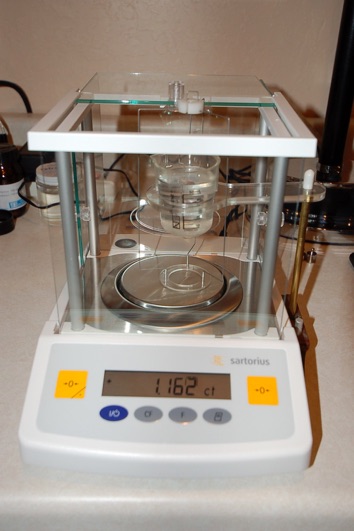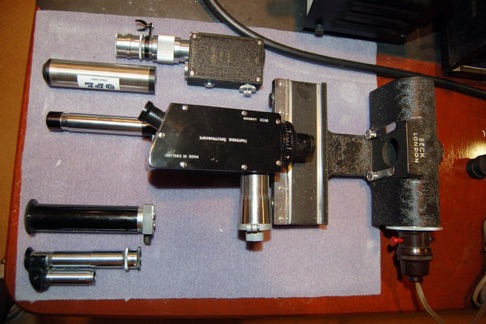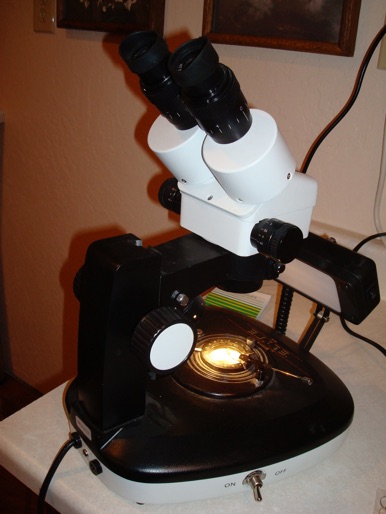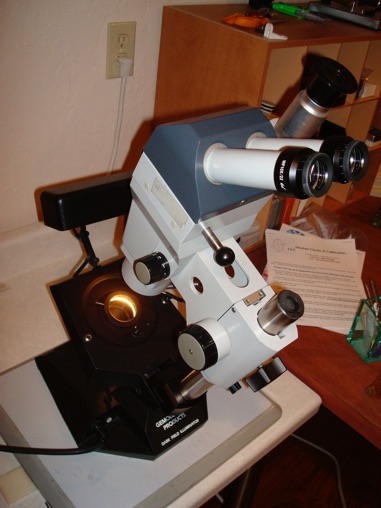Gemology for Faceters #1

by l. bruce jones
We all share a fascination with gemstones and the efficient practicing of our craft of faceting requires that we learn something about the gems that we cut. In my case I was a faceter first, then a geologist specializing in mineralogy and then a gemmologist and gem lab operator and finally, a part time researcher trying to coerce the secrets from gem materials. But if it wasn’t for learning to facet all those years ago I would have no knowledge today of the science that has made my life immeasurably richer.
As faceters, the study of the gems that we cut can teach us a lot and it can make our cutting better as well. There are a wide variety of books and videos and formal courses that we can seek out in our investigation of gem materials, but not many of them relate directly to the gemmology pertinent to the gem cutter.
I thought that a series of articles on gemmology for faceters would be useful. But where to start? Clearly, understanding the physical and optical properties of gem materials as it relates to our faceting the raw crystals into gems would be pertinent, but is there anything more pressing?
We all have to buy rough. Fortunately, most dealers, particularly those that we establish long term relationships with, are scrupulously honest about representing the nature of the gem materials they sell. But, do they always know? Do they take the word of their suppliers and do their suppliers always know for sure? All of us have no doubt seen material that was suspect and perhaps the deal was so good that we even purchased it, not being sure of what it was. And even though the majority of sellers might be honest, the further you travel from home in the pursuit of gem materials, the more you need to know to protect yourself. I can remember years ago consulting for a buyer at a gem mine in Thailand where the miners were salting their claims with synthetic Knischka ruby crystals!
Now, more than ever before, sophisticated synthetics, and all manner of treated and manipulated stones exist that are often not what they are represented to be.
As faceters, then, perhaps one of the most valuable skills to have and to learn is the capability of identifying gem species. Particularly if we are selling the stones we cut. Then we have an absolute obligation to be accurate in our representations. “I didn’t know,” is no excuse.
Now, given that we want to improve our identification skills, where do we start?
Most courses in gemmology start with basic mineralogy. Defining a mineral, attempting to understand basic crystallography, crystal systems and classes, crystal chemistry etc. That then gets translated into the complexities of optical mineralogy. It’s all important to an in-depth understanding of the subject but its pretty dry stuff. For those interested, the best basic introduction can be found in the book Gemology, by Hurlbut and Kammerling, now out of print. By far the best book on mineralogy is quite recent. Entitled, Mineralogy and Optical Mineralogy by Dyer & Gunter, it is published by the Mineralogical Society of America and is the finest book on the subject ever published.
Let’s take a more instrument oriented, practical approach to learning about gem I.D. And let’s start with, “Just what instruments are available and how relevant are they?”
Gem Instruments
I admit to being an instrument junky. I’m currently writing a book on gemmological instruments and it gives me a great excuse to indulge myself in a wide variety of gemmological and mineralogical periphernalia that runs the gamut from the mundane to the horribly exotic. The horribly exotic has taken over my sunporch in the form of 7500 lbs of electron microprobe. Want to see how good your marriage really is? Try installing one of those and explaining the “budget modifications” to your wife.
The Number 1 Gem I.D. Instrument Is?
Many might vote for the hand lens but in most cases it is an instrument to evaluate quality save in some circumstances. Then there is the microscope. Great to see meets, double refraction and inclusions, but not quite the first stop when it comes to I.D.
#1: The Critical Angle Refractometer
One thing we faceters can do easily is polish a flat spot on a piece of rough and so the prerequisite for using a refractometer is met. If you have a finished gem it’s even easier. A drop of contact fluid on the hemicylinder and away we go.
A refractometer will provide you with information on the refractive index, birefringence, optic sign and optic character and even dispersion. Combined, they will provide a highly definitive result in most cases. We’ll explain all those terms in the next installment which will concentrate on the refractometer and its use.
The bad news about a gem refractometer is that a good instrument is expensive ($550-$950). The four best instruments are made by Gemmological Products (Gem Pro refractometer), Rayner Instruments (Dialdex), GIAs Gem Instruments (Duplex II) and System Eickhorst (SR 0.01). The good news is that with proper care they will last a lifetime and a good refractometer, given an appropriate light source, is the most important instrument you can own. Avoid the cheap Chinese eBay instruments that cost in the $100 range.

#2 Specific Gravity Kit & Scale
Most faceters have an electronic scale that is accurate to 0.01 carats. With a specific gravity attachment, such as the one sold by Mineralab for $79, you can determine the specific gravity (e.g. relative density) of the stone in question. With a scale of .01 ct precision and accuracy (available for about $100), you can expect an accurate S.G. reading down to about .41 carats. If you have an analytical scale that reads to a thousandth of a carat (0.001) you can expect accurate readings down to about 0.04 cts. We’ll discuss techniques in a future installment but the weight in air divided by the weight loss in water (e.g. weight loss in water = weight in air minus weight in water) gives you a relatively determinative number that you can then look up in a table of gemstone physical values. The best published source of determinative tables for gemstones is Tables of Gemstone Identification by Dedeyne & Quintens available at http://www.gemmologie.be

#3 The Diffraction Grating Spectroscope
A spectroscope breaks the light that passes through a gem into its component colors where one can see, in many cases, characteristic absorption lines valuable in identifying the stone. A very good inexpensive spectroscope is the OPL Teaching model from Orwin Products in the U.K. The cost is about $100, although a light source/stand can add to that price. Colin Winter, the owner of the company, has written a very nice book on gem spectroscopy called A Students’ Guide to Spectroscopy. Next up in price are several prism spectroscopes with scales that more easily assist the viewer in determining the location of the absorption lines and oftentimes these units include a light source stand combination.

The ultimate tool in this category is the Challenger Gemological Spectrometer which uses a monitor/camera and accurate wavelength scale to make viewing very simple and also is capable of readings in the near infrared. The price is $3200 and the Challenger is made by Imperial Gem Instruments. The company also builds the Alpha-Taurus faceting machine.

#4 The Gem Microscope
A good microscope is useful to most faceters as an unyielding arbiter of mistakes. Beyond that a good binocular gem microscope introduces one to the internal world of gemstones and the study of inclusions, a science in and of itself. Inclusion identification can tell us a great deal about many gems and oftentimes it is a suite of inclusions that bears mute testimony to a gem’s geographic source and conditions of formation. The ultimate guide to gem inclusions is a series of three volumes entitled Photoatlas of Inclusions in Gemstones by Gübelin & Koivula.

The microscope is a great tool for separating natural from synthetic, imitation and assembled stones and for quality grading of both diamonds and colored stones. Properly equipped, a microscope can measure distances, evaluate proportions and even estimate refractive index.
To be useful for gemmology, a microscope must have a gemmological base that includes both darkfield and brightfield illumination. Without a fully effective gem base the microscope’s usefulness is dramatically diminished. It is very difficult for anyone but an expert to tell the difference in the quality of the optics of a microscope, but poor lighting is immediately obvious. A good new ‘scope to start with is the Gem Oro Elite 1067ZX for about $875. From there, Meiji or GIA gem scopes are very good as are the scopes by Eickhorst or Krüss. In addition, GIA Gemolites with AO or Bausch and Lomb optics often come up on eBay at reasonable prices.
The ultimate gem base is made by Jeff Wildman’s Gemological Products and he’ll fit the $2000 base with a new or reconditioned scope from Leica or Nikon for a reasonable price. If you can find a Wild M8, M400 or M420 with a photoport or, even better, a Zeiss Stemi V8 or V10 with photoport then you have the ultimate microscope set-up for gemmology.

#5 Other Equipment
Other pieces of equipment are quite useful in a well set up gem lab but if you buy just one instrument, it should be a good refractometer. We’ll discuss its use next time. Here are just some of the additional equipment possibilities.
Polariscope
Dichroscope
Fiber optic lightsource
Assorted color filters
U.V. lights and viewing cabinet
Measuring devices
Specific gravity liquids
R.I. immersion liquids
Immersion microscope
Hardness points
Geiger counter
Reference books and software
Download a .pdf version of this article: gem equip overview.pdf
